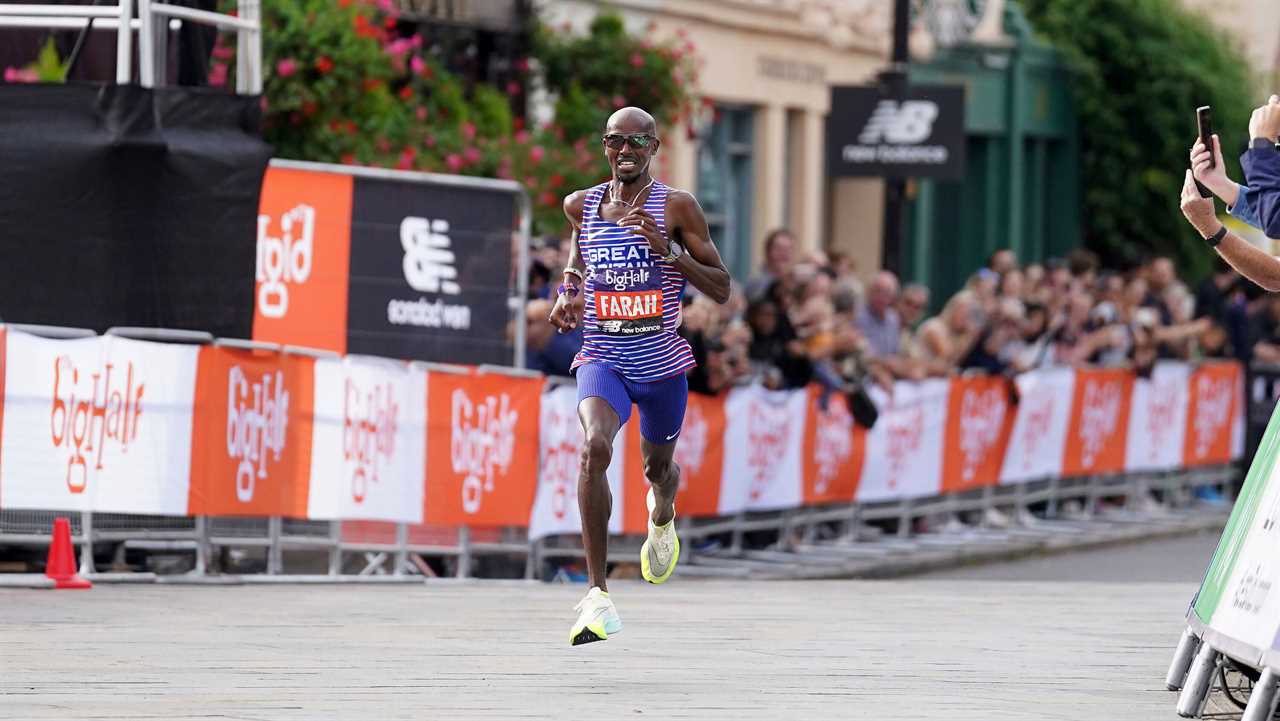
It has been a running career of remarkable success and breadth and revelation: four Olympic gold medals won at 5,000 and 10,000 meters, a brave disclosure of being trafficked as a young boy, a knighthood conferred by Queen Elizabeth II — even a pose called the Mobot that celebrated the infectious joy with which Mo Farah of Britain prevailed.
What exquisite range. At 1,500 meters, the metric mile, Farah ran 3 minutes 28.81 seconds in 2013, becoming at the time the sixth-fastest man ever in the event. In 2018, he set a European record in the marathon, since broken, by winning in Chicago in 2 hours 5 minutes 11 seconds. But now, at 39, Farah’s competitive career may be reaching the finish line.
On Wednesday, he dropped out of the London Marathon on Sunday with a hip injury. Farah has said his track career is done, and it remains unclear whether he will attempt another marathon. He has not entered the event except as a pacemaker since 2019 and has acknowledged that the distance of 26.2 miles remains a puzzle unsolved. That seemed evident when he attempted, and failed, to qualify for the delayed Tokyo Olympics on the track instead of in the marathon.
Farah has been plenty fast in the marathon, just not among the fastest, as many predicted he would be when he left the track for the roads. So searing is the race at the elite level — covering more than 26 miles in less than five minutes per mile — that Farah’s best time, 2:05:11, now ranks tied for 161st place among all performances.
“I still have the hunger,” Farah said in July upon announcing his planned entry in the London Marathon. But, he wondered, presciently, “Can my body compete with these guys at this level?”
His withdrawal seems a time for reflection and assessment. Could Farah have run a minute faster in the marathon, or even two minutes faster, given his track speed and the deep pockets of support from Nike?
Could he have joined the pantheon of track stars turned marathon greats, like Eliud Kipchoge of Kenya, a two-time Olympic gold medalist who stunningly lowered his own world record by 30 seconds to 2:01:09 last Sunday in the Berlin Marathon? Like Kenenisa Bekele of Ethiopia, a three-time Olympic gold medalist on the track who ran the second-fastest marathon ever at 2:01:41? Like Haile Gebrselassie of Ethiopia, now retired, a two-time Olympic gold medalist in the 10,000 meters who was the first person to run a marathon under 2:04? Like Paul Tergat of Kenya, also retired, who once held the world record at 2:04:55?
“Theoretically speaking, you would have expected him to have been able to at least challenge the likes of Kipchoge and Bekele and so on,” Yannis Pitsiladis, a marathon researcher and exercise physiologist at the University of Brighton in England, said of Farah. “And he never did.”
Why not? “You can’t be the best at everything,” said Weldon Johnson, a co-founder of LetsRun.com who in 2002 paced Paula Radcliffe of Britain to her first world record in the marathon. “We shouldn’t let the marathon detract from his greatness on the track.”
A trade-off is inevitable between the enormous anaerobic capacity needed to surge over the final laps of a track race, which Farah had in sprinting to Olympic gold medals, and the aerobic endurance required to maintain a steady, blistering pace over a marathon, said Andrew Jones, an exercise physiologist at the University of Exeter in England who has studied the performances of Farah and Kipchoge.
Simply put, said Alex Hutchinson, a columnist for Outside Magazine and the author of “Endure: Mind, Body and the Curiously Elastic Limits of Human Performance,” Farah’s problem “isn’t that he’s not good at longer distances; it’s that he’s too good at shorter distances.”
Compared with Farah, Kipchoge has superior “critical speed,” or the maximum aerobic speed that can be sustained, Jones said, which would be a significant advantage over 26.2 miles. Kipchoge might also have more sustainable running economy, the amount of oxygen required to run at a given speed, Jones said, which would lessen his fatigue later in a marathon.
Farah’s bounding, loping gait contrasts with the flowing, metronomic style of classic marathon running and is “probably a little more energy expending,” said Amby Burfoot, the winner of the 1968 Boston Marathon and a longtime editor at Runner’s World magazine.
There are also fewer opportunities for runners to experiment with their strategy and tactics in the marathon compared with their ability to do so while racing on the track. While runners could race once a week at the peak of their season on the track, elite marathoners usually run only two marathons a year, and there are a finite number of top races even in the fastest legs (though Kipchoge is challenging that notion). A lot can go wrong over two hours.
Experts who were interviewed wondered whether Farah had difficulty fueling during a marathon, which is not required at shorter distances. Or whether he had the patience for a 26.2-mile grind. Or if he could muster the same motivation after such a brilliant career on the track.
In a small group interview recently, Kipchoge said moving from the track to the marathon requires “moving the goal posts” in a runner’s mind. By that, he meant an acceptance of the tiresome but consistent training that is necessary.
“When your mind is OK, then the muscles are good,” Kipchoge said.
In May, Farah acknowledged that his track career was finished after he lost a 10-kilometer road race to a sub-elite runner who had to pay a fee to enter. But in early September, Farah won the Big Half, a half-marathon, in London in 61:49. On Wednesday, he said in a statement that he had felt “pretty optimistic” about his chances in the London Marathon. But two weeks before the race date, he began feeling pain and tightness in his right hip, which did not respond sufficiently to physiotherapy.
“Really disappointing,” Farah said.
If his marathon career is done, he can take some consolation from Michael Joyner, a physiologist at the Mayo Clinic who studies the limits of human endurance. Based on predictive models using a runner’s best time at 10,000 meters — Farah’s was 26:46.57, the 35th-fastest time ever run — his marathon best of 2:05:11 “is very reasonable,” Dr. Joyner said.
“Not everybody is Kipchoge,” he said of Farah. “The guy is a bit of a prisoner of his success on the track. But 2:05 is fantastic.”
-----------------------
By: Jeré Longman
Title: Can Mo Farah Still Race at the Top Level?
Sourced From: www.nytimes.com/2022/10/01/sports/mo-farah-london-marathon.html
Published Date: Sat, 01 Oct 2022 09:00:16 +0000
Did you miss our previous article...
https://ballerawards.news/sports/arrests-and-warnings-as-iranian-soccer-stars-take-side-in-protests






